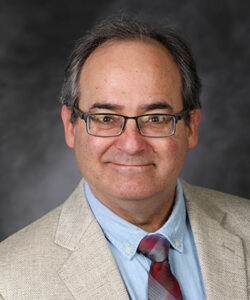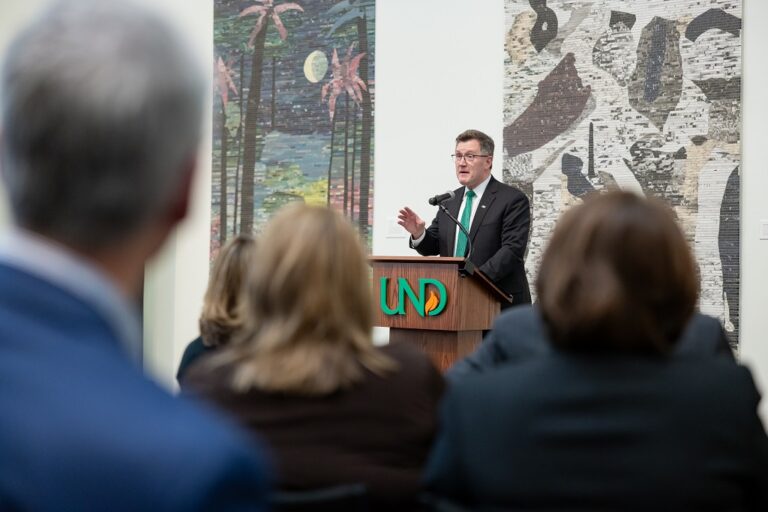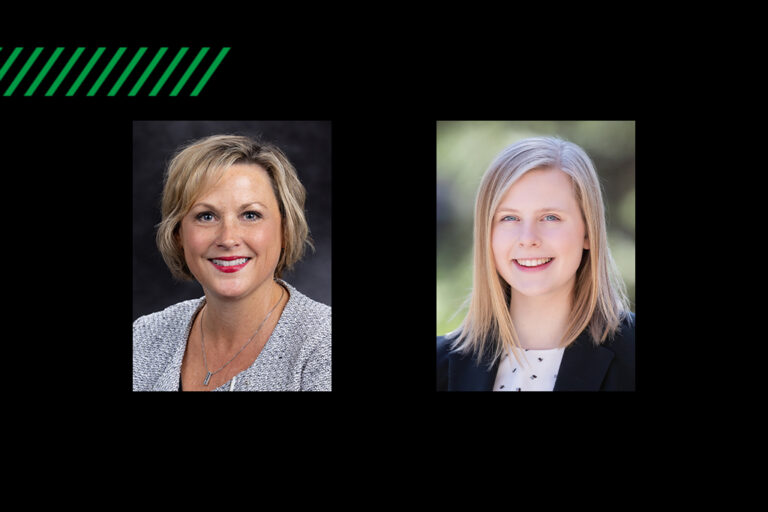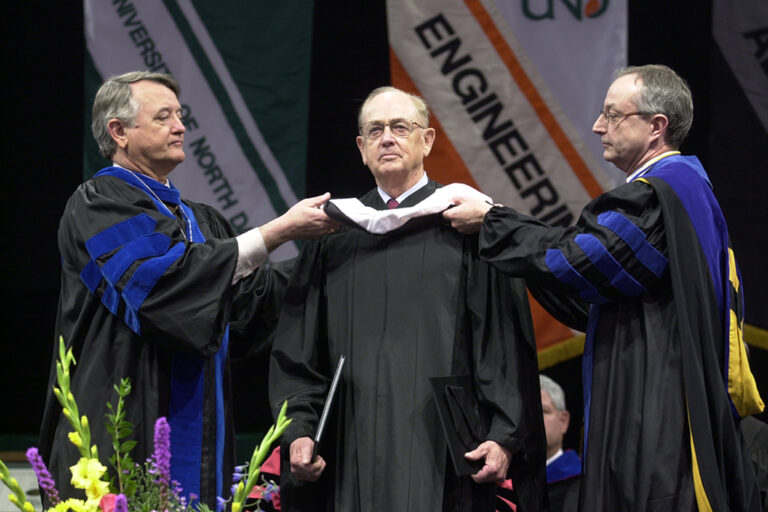Building on the One UND Strategic Plan
The plan remains a ‘solid framework’ for UND to overcome challenges and achieve goals, president says in State of the University Address
Editor’s note: The University of North Dakota’s University Council held its fall meeting via Zoom on Monday, Oct. 26; and as part of the meeting, UND President Andy Armacost delivered his State of the University Address.
Videos of the meeting and of the President’s address are above, and a transcript of the President’s address (and the short Q&A that followed) is below.
President Armacost: Thanks, Professor Legerski, for your great leadership of the Senate, and also for pulling today’s University Council together. And thanks also to the deans for the great presentations, and to next spring’s group of deans, who will present then (at next spring’s University Council meeting). I think everybody watching today got a very good sense of the type of issues that each of our deans are facing and how they’re looking forward to the future.
Today’s discussion is quite a different format than perhaps what you’ve seen in past years. I hope that you’ve found it useful so far.
When this was characterized as the State of the University, that title conjures some interesting thoughts. I really don’t think that you should have to wait to once a year or once a semester to interact with the president and to hear what I’m thinking. This is why we’ve made every effort to get the word out about goings-on on a routine basis. And thanks to all of you who have tuned in to the biweekly letters and the videos that we’ve put out.
Let me say that my first months at UND have been a whirlwind, with so much to learn about among the faculty, the staff and the student body. And I’ve truly admired the sheer determination of so many to pull off a semester under the heavy weight and the uncertainty of the COVID-19 pandemic.
And so, let me begin my remarks really focusing on COVID. Our Pandemic Working Group has been at it since mid-March. And their work has been absolutely, in my opinion, extraordinary. They’ve been forward-thinking and responsive to change and have laid a great foundation for the campus to operate.
They’ve identified campus needs and garnered state and federal funding for the supplies, for the testing, for the hotel rooms, for disinfection, for meals and housing and for so much more.
And through the work of this group, and under the leadership of Jen Berger, Eric Plummer and Jed Shivers, I think that UND has been a leader across the state, and so supportive of other members of the North Dakota University System.
They’ve really gotten tens of millions of dollars in funding to UND to keep our campus at minimal risk. And kudos to all of them.
As we continue to respond to the pandemic, we need all our members to continue to practice the good personal habits, both on campus and just as importantly, off campus as well.
Speaking of off campus, I’ve written a letter to the mayor and to the City Council that describes the importance that we found with mask wearing and do encourage him and the City Council to adopt a citywide mask requirement, just as we have done on campus — and in fact, we did it months ago.
Our student government has also done the same, and they’ve been true leaders in getting this on the City Council’s docket for this evening.
I will join Student Body President Matt Ternus and Vice President Kaelan Reedy at tonight’s City Council meeting.
I will continue to support individual faculty members as each of you determine how you should best meet the educational needs of your students, while also considering health and safety.
This has been my commitment to you as we began planning for the fall semester months ago.
I would also implore you to look out for your students to a degree that you’ve never done before. Now is the time that they need you, your wisdom and your compassion.
Let me turn for a little bit to the budgetary picture. We do face pressures from two of our key funding sources: tuition and the state appropriation from North Dakota.
On the tuition side, we have been fortunate that our enrollment this year was slightly above last year’s enrollment, although we had earlier predicted a 10 percent decline. As the pandemic continues, we continue to run the risk of families making tough decisions about college funding. And so we’ll watch this very carefully as we go from fall semester to spring semester.
Though we do know that UND is a great education at a great price, and we need to tell that to our students and their families.
Like we did in the spring semester, we’re launching a major outreach effort to our students to ensure they have good information as they and we begin to plan for the spring semester. We want them, by all means, to continue their strong steps toward finishing their their degrees here at UND.
Let me also talk a bit about the state budget for the next biennium. As you know, the governor presented his proposed budget; and in that budget, a 10 percent reduction in the funding for higher education. The State Board of Higher Education countered by submitting a needs-based budget, which is based on the previous biennium budget plus a marginal increase for specific needs.
This would yield a slight overall increase in our state appropriation.
The upcoming legislative session will determine what the state appropriation will actually be for the 2021-23 biennium. We continue to work with legislators and their staffs to provide information to them, and to our UND caucus, who will help advocate for what we think we need for the upcoming biennium.
The strategic direction of the university is also important. We have COVID, we have budget uncertainty, but we still have to think towards the future.
I believe that the One UND Strategic Plan is a solid framework for our university, and we’ll stick with it.
There are several areas of immediate interest. Let me say a few words about those.
Goals One through Three tie to the delivery of our academic programs, and the success we hope our students achieve. And I want to draw your attention to a task force that Provost Storrs and I recently chartered. This is the Task Force on the Future of Education at UND.
The co-chairs are Professor Jeff VanLooy and Professor John Shabb, who are currently soliciting volunteers as you heard earlier and building their team of the members of this task force.
This important committee will examine UND’s educational delivery, economic models, and synergy between on campus and online experiences. As you know, the national environment of higher ed is being upheaved by existing trends, plus COVID. And we need to position our university for long term success.
Goal Four is our research program, and I have committed to continuing the research Grand Challenges, while also supporting faculty scholarship in areas outside those Grand Challenges.
As we continue to grow programs in human health, rural health, autonomy, Big Data and energy, we will also explore ways to connect to national security. Recent visits to our campus by leaders of the new Space Force highlight additional opportunities for discovery and learning, and areas related to space launch, orbital control, engineering, space policy, philosophy, physics, and entrepreneurship.
Kudos to Vice President John Mihelich and his team, Dean Paul Lindseth and his Odegard School team, and Dean Brian Tande and his College of Engineering and Mines team for hosting these space leaders.
This also ties to Goal Three, as you can imagine, as faculty members will consider how this space work might alter our academic offerings, and also perhaps our hiring.
Let me turn to Goal Five, and this is to create an inclusive UND community.
This summer, I commissioned a Task Force on Diversity, Equity and Inclusion, and this is chaired by Dr. Cara Halgren and Professor Tamba-Kuii Bailey. The task force will deliver their initial thoughts on Nov. 9, and we will have subsequent conversations to allow me to better understand the details of their work.
Shortly after Thanksgiving, we will release the key findings of the task force to the campus and to the public.
Goal Six relates to our serving the veterans community, and I will be directly involved as the co-captain for this goal, given my 30 years of active duty Air Force experience.
There are many ways to support our veterans as undergraduate and graduate students through curriculum research and opportunities for entrepreneurship. Many thanks to the partnership on this team, with Angie Carpenter and Jessica Reule and their leadership that has existed in this area for a couple of years.
Finally, Goal Seven ties to our alumni support, and this has been a true success story. Under the leadership of DeAnna Carlson Zink, philanthropic support to our campus community has never been higher, with more than $80 million raised in the last fiscal year.
Our primary fundraising efforts center on student scholarships, endowed faculty lines and capital projects. Of note this year was the groundbreaking on the new Nistler College of Business and Public Administration, made possible by the anchor donation of $20 million by Werner and Colleen Nistler.
Generosity of this type is both for the long term and the short term. And so, many thanks to the Foundation for their work on raising private donations for the Angel Fund, which covers short-term financial emergencies for our students, and the Open Door Scholarship Program, which supports need-based scholarships in the wake of the COVID pandemic.
Beyond this strategic plan, there are so many great things happening on campus, and I’ve been in the front row of many of these. (It might be a virtual front row!)
The Writers Conference, under the leadership of Professor Crystal Alberts, is in full swing. I’ve been happy to have been a part of their sessions to hear some truly amazing speakers.
I’ve been happy to be part of many other events, events like the School of Law convocation, the Department of Music’s Fall Recital, the Nursing Ph.D. Students Seminar, the Honors Program admissions event, and so many others.
I wish that we weren’t distanced as we have been, but I certainly look forward to being an important part of your lives, whether virtually or in person, and to serve as an advocate and as a strong supporter of all the work that you’ve been doing.
I feel privileged to be a part of this outstanding community of scholars and leaders. Speaking of leaders, I’m eager to soon begin the review of candidates for our provost and vice president for academic affairs position, as well as our dean of the Odegaard School of Aerospace Sciences.
The search committees are under the leadership of Associate Dean Beth Bjerke and Professor David Flynn for the provost, and Dean Amy Henley and Dean Cindy Juntunen for the Odegaard dean.
These times are both exciting and challenging, I can assure you that we will continue to grow as a community and tackle our toughest challenges together with even greater involvement and input from faculty, staff, and students.
It’s an exciting time to be at UND, and I thank you for being here today. I think we do have a few minutes for some final questions in the next seven minutes or so.
Associate Professor Elizabeth Legerski, University Senate chair: Thank you so much for that great summary. Well, we do have about eight minutes left, where we can entertain some questions from the University Council members. We likely won’t have time to answer every question, but there will be opportunities, I believe, in the future for some Town Halls. And so, save your questions for them, or we’ll do our best to answer them at another time.
About the Town Halls. President Armacost, do you want to talk about those coming up?
President Armacost: Yes. So, we have two Town Halls coming up on Wednesday, Nov. 4. There is one at noon for faculty and staff, and then one in the evening at 6 p.m. for students and their families.
As we know, families are actively involved in decisions about a student’s future. So we thought it was important to connect with them as well.
Professor Legerski: Great, thank you. Somebody was asking about when the City Council meeting is tonight, but that information is available online.
President Armacost: That’s at 5:30. tonight down at City Hall.
Professor Legerski: The question is, does UND plan to test students before spring semester like we did in the fall? It’s a good question.
President Armacost: Well, we do plan on having active test events, hopefully to the extent that we did this past fall.
As you know, we either do one or two major testing events per week, and we’ll be working with the State Department of Health to pin down the schedule. So, stay tuned for what the schedule is.
We all know the power of testing. When when we test, we can identify instances of the virus and then take actions to support those members and to make sure that their close contacts are taken care of as well. So, the plan is to do that, and in addition, there are other targeted opportunities as well that will work closely with the State Department of Health, including post-Thanksgiving and also post-Spring Break.
Professor Legerski: Someone had also asked, related to that, if we’re going to have students test before leaving to go back to their hometowns for Thanksgiving or after Thanksgiving?
President Armacost: Right. The direction from Dr. Deborah Birx from the President’s Task Force, if you remember, before Labor Day, there was a huge push to make sure people actually stayed in place for Labor Day. But if not, we had encouraged them to test before they they went so they would know if they were infected. We will make the same encouragement for people leaving to go to Thanksgiving to make sure that we’re not bringing anything from Grand Forks back home.
Professor Legerski: Some folks are also interested in decisions about when spring semester will start and whether or not we’ll have Spring Break.
President Armacost: The University System has made a collective decision that we want consistency across all 11 schools in the system. And consequently, the start of the semester will happen, as originally planned. And Spring Break will happen as planned as well.
Professor Legerski: Someone is asking: Right now, there are a number of book groups going on out regarding the book, “How to be an Anti Racist.” So, this person is wondering if, in addition to implementing the findings of the Task Force, you’d be willing to take recommendations from other segments of the UND community about additional things that we can do to address these issues?
President Armacost: That’s a great question, and the answer is absolutely. And there are probably many mechanisms by which you can actually submit this.
One is to reach out directly to a Task Force member and, and share your thoughts with them. They’re still finalizing their recommendations at this point.
The alternate way is, perhaps what I could ask each of the reading groups to do, is to actually to get together and to share your ideas about this — about what other ideas that you might have for UND. And then collect those as part of your group and submit them; you can submit them up to me, or through Cara Halgren or Tamba-Kuii Bailey. That’s probably the best way, since they’re the chairs of the task force.
So lots of ways, and just because you didn’t participate in the Task Force or didn’t share information with a Task Force member, we don’t want your voices and your ideas to not be heard.
Professsor Legerski: Someone was also wondering if we had any numbers about how many faculty are moving classes online after Thanksgiving?
President Armacost: That is a great question. We’ll see if Provost Storrs will submit an answer online.
I don’t have those numbers. I know there was a small uptick in the number of courses that were going to be offered online; it was actually smaller than what I was expecting. But what I want to express is my appreciation for those who are continuing to figure out the best way to operate their courses, and the best way to teach.
As I said in my my prepared remarks, the balance of health and safety along with with high-quality education in the way that you would like to deliver it can be challenging in a time of a pandemic. I realize that.
But keep also in mind that I think the safest place that we’ve seen on campus is actually the classroom — that the incidents of spread generally are outside of the classroom and generally off campus as well.
So know that we’re in what I think is a minimal risk environment while we’re in the classroom.
There was one other question, too, about, are we expecting the 10 percent budget cut in the summer of 2021? What I was trying to capture earlier was the fact that the governor put a proposal together that was a 10 percent cut. And the State Board of Higher Education came back with a proposal that did not have the 10 percent cut. In fact, it had a marginal increase in the funding for higher ed.
So, what will happen now is the Legislature will determine what that budget looks like and what they decide to approve for higher education.
We’ll have a better sense as we start talking to the legislators during the session to see what direction it might head, but I know that they typically wait until pretty late in the session before they approve the higher ed budget. It’s generally one of the last things that’s approved.
So be patient, and we’ll keep you posted on what happens.
Professor Legerski: Real quick here: Debbie Storrs typed in some information for us.
So according to Provost Storrs, we have about 30 percent online and 70 percent on campus. But faculty are still able to modify their delivery methods, so that could change.
Well, we have reached our time. So I would like to thank everyone for being here. Thank you to our deans, and thank you to President Armacost for sharing with us and reviewing with us all the great things happening on campus. It’s a privilege to work with you and to hear about all the great things happening.
So I just like to say thank you and encourage everyone to stay healthy and well until our next meeting in the spring. Thank you!



